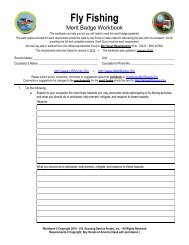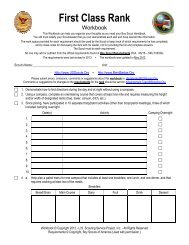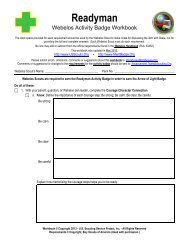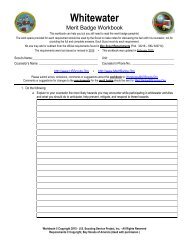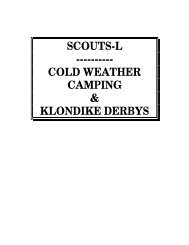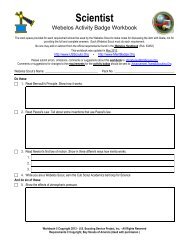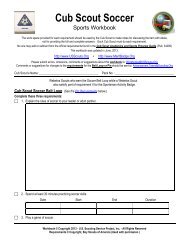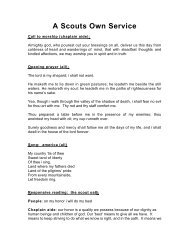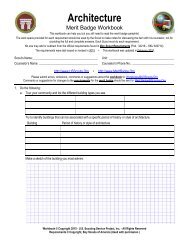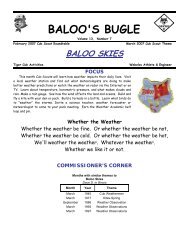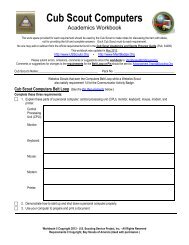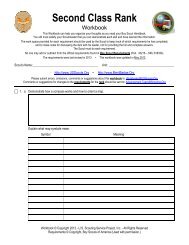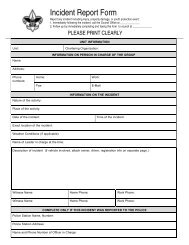Webelos Badge Worksheet - Merit Badge Research Center
Webelos Badge Worksheet - Merit Badge Research Center
Webelos Badge Worksheet - Merit Badge Research Center
You also want an ePaper? Increase the reach of your titles
YUMPU automatically turns print PDFs into web optimized ePapers that Google loves.
<strong>Webelos</strong> <strong>Badge</strong><br />
<strong>Webelos</strong> Workbook<br />
The work space provided for each requirement should be used by the <strong>Webelos</strong> Scout to make notes for discussing the item with Akela,<br />
not for providing the full and complete answers. Each <strong>Webelos</strong> Scout must do each requirement.<br />
No one may add or subtract from the official requirements found in the <strong>Webelos</strong> Handbook (Pub. 33452)<br />
This workbook was updated in May, 2013.<br />
http://www.USScouts.Org • http://www.<strong>Merit</strong><strong>Badge</strong>.Org<br />
Please submit errors, omissions, comments or suggestions about this workbook to: Workbooks@USScouts.Org<br />
Comments or suggestions for changes to the requirements for the Arrow of Light should be sent to: Advancement.Team@Scouting.Org<br />
<strong>Webelos</strong> Scout’s Name: __________________________________<br />
Pack No. :______________________________________<br />
Do these:<br />
1. Have an adult member of your family read the <strong>Webelos</strong> Scout Parent Guide that comes with this (The <strong>Webelos</strong><br />
Handbook) book (pages 1-22) and sign here.<br />
2. Be an active member of your <strong>Webelos</strong> den for 3 months (Active means having good attendance, paying your den dues,<br />
working on den projects).<br />
3. Know and explain the meaning of the <strong>Webelos</strong> badge.<br />
4. Point out the three special parts of the <strong>Webelos</strong> Scout uniform.<br />
1.<br />
2.<br />
3.<br />
Tell when to wear the uniform and when not to wear it.<br />
Workbook © Copyright 2013 - U.S. Scouting Service Project, Inc. - All Rights Reserved<br />
Requirements © Copyright, Boy Scouts of America (Used with permission.)
<strong>Webelos</strong> <strong>Badge</strong><br />
<strong>Webelos</strong> Scout's Name: ________________________<br />
5. Earn the Fitness and Citizen activity badges and one other activity badge from a different activity group .<br />
Fitness activity badge<br />
Citizen activity badge<br />
One other activity badge:__________________________<br />
6. Plan and lead a flag ceremony in your den that includes the U.S. flag.<br />
7. Show that you know and understand the requirements to be a Boy Scout.<br />
a. Demonstrate the Scout salute, Scout sign, and Scout handshake.<br />
Scout salute<br />
Scout sign<br />
Scout handshake<br />
Explain when you would use them.<br />
b. Explain the Scout Oath, Scout Law, Scout motto, and Scout slogan<br />
<br />
Scout Oath<br />
<strong>Webelos</strong> <strong>Badge</strong> Workbook Page 2 of 6
<strong>Webelos</strong> <strong>Badge</strong><br />
<strong>Webelos</strong> Scout's Name: ________________________<br />
<br />
Scout Law<br />
<br />
Scout motto<br />
<br />
Scout<br />
slogan<br />
c. Explain and agree to follow the Outdoor Code.<br />
8. Faith<br />
After completing the rest of requirement 8, do these (a, b, and c):<br />
a. Know: Tell what you have learned about faith.<br />
b. Commit: Tell how these faith experiences help you live your duty to God.<br />
<strong>Webelos</strong> <strong>Badge</strong> Workbook Page 3 of 6
<strong>Webelos</strong> <strong>Badge</strong><br />
<strong>Webelos</strong> Scout's Name: ________________________<br />
Name one faith practice that you will continue to do in the future.<br />
c. Practice: After doing these requirements, tell what you have learned about your beliefs.<br />
And do one of these (d OR e):<br />
d. Earn the religious emblem of your faith*<br />
e. Do two of these:<br />
Attend the mosque, church, synagogue, temple, or other religious organization of your choice, talk with<br />
your religious leader about your beliefs. Tell your family and your <strong>Webelos</strong> den leader what you<br />
learned.<br />
Discuss with your family and <strong>Webelos</strong> den leader how your religious beliefs fit in with the Scout Oath<br />
and Scout Law, and what character-building traits your religious beliefs have in common with the Scout<br />
Oath and Scout Law.<br />
With your religious leader, discuss and make a plan to do two things you think will help you draw<br />
nearer to God.<br />
<strong>Webelos</strong> <strong>Badge</strong> Workbook Page 4 of 6
<strong>Webelos</strong> <strong>Badge</strong><br />
<strong>Webelos</strong> Scout's Name: ________________________<br />
Do these things for a month.<br />
1.<br />
2.<br />
For at least a month, pray or meditate reverently each day as taught by your family, and by your<br />
church, temple, mosque, synagogue, or religious group.<br />
Under the direction of your religious leader, do an act of service for someone else. Talk about your<br />
service with your family and <strong>Webelos</strong> den leader. Tell them how it made you feel.<br />
List at least two ways you believe you have lived according to your religious beliefs.<br />
1.<br />
2.<br />
* If you earned your faith's religious emblem earlier in Cub Scouting, and your faith does not have a <strong>Webelos</strong><br />
religious emblem, you must complete requirement 8e.<br />
Completion of requirement 8e does not qualify a youth to receive the religious emblem of his faith.<br />
Requirement resources can be found here:<br />
http://www.meritbadge.org/wiki/index.php/<strong>Webelos</strong>_<strong>Badge</strong>#<strong>Webelos</strong>_Rank_Requirement_Resources<br />
<strong>Webelos</strong> <strong>Badge</strong> Workbook Page 5 of 6
Important excerpts from the Guide To Advancement - 2013, No. 33088 (SKU-618673)<br />
[1.0.0.0] — Introduction<br />
The current edition of the Guide to Advancement is the official source for administering advancement in all Boy Scouts of America programs: Cub<br />
Scouting, Boy Scouting, Varsity Scouting, Venturing, and Sea Scouts. It replaces any previous BSA advancement manuals, including Advancement<br />
Committee Policies and Procedures, Advancement and Recognition Policies and Procedures, and previous editions of the Guide to Advancement.<br />
[Page 2, and 5.0.1.4] — Policy on Unauthorized Changes to Advancement Program<br />
No council, committee, district, unit, or individual has the authority to add to, or subtract from, advancement requirements. There are limited<br />
exceptions relating only to youth members with special needs. For details see section 10, “Advancement for Members With Special Needs”.<br />
[Page 2] — The “Guide to Safe Scouting” Applies<br />
Policies and procedures outlined in the Guide to Safe Scouting, No. 34416, apply to all BSA activities, including those related to advancement and<br />
Eagle Scout service projects.<br />
[4.1.0.3] — Who Approves Cub Scout Advancement?<br />
A key responsibility for den leaders is to implement the core den meeting plans as outlined in the Den & Pack Meeting Resource Guide, No. 34409.<br />
For the Bobcat trail and Tiger Cub achievements, parents (or adult partners) should sign in the boy’s handbook; the den leader then approves as<br />
progress is recorded in the den’s advancement record. For Wolf, Bear, and <strong>Webelos</strong> advancement, den leaders take the lead in approving<br />
requirements, though their assistants, and also parents who help at meetings, may be asked to play the role of “Akela” and assist. Parents sign for<br />
requirements that, according to meeting plans and instructions in the handbooks, take place at home.<br />
[4.1.0.4] — “Do Your Best”<br />
Cub Scouts—even those of the same age—may have very different developmental timetables. For this reason, advancement performance in Cub<br />
Scouting is centered on its motto: “Do Your Best.” When a boy has done this—his very best—then regardless of the requirements for any rank or<br />
award, it is enough; accomplishment is noted. This is why den leaders, assistants, and parents or guardians are involved in approvals. Generally they<br />
know if effort put forth is really the Cub Scout’s best.<br />
In the same spirit as “Do Your Best,” if a boy is close to earning a badge of rank when the school year ends, the pack committee, in consultation with<br />
the den leader and the Cub Scout’s parent or guardian, may allow him a few weeks to complete the badge before going on to the next rank. Earning it<br />
will give him added incentive to continue in Scouting and carry on and tackle the next rank.<br />
[4.1.2.2] — Cub Scout Academics and Sports Program<br />
More than just a recognition opportunity, this program develops new skills, improves those existing, and otherwise enriches Cub Scouting. Details can<br />
be found in the Cub Scout Academics and Sports Program Guide, No. 34299. Activities include subjects like science, video games, collecting, and<br />
chess; and sports such as baseball, skateboarding, and table tennis. Each has two levels—a belt loop and a pin. Belt loops are awarded when each of<br />
three requirements is met. Cub Scouts may then continue with additional requirements and earn the pin. Belt loops and pins may be earned more than<br />
one time. Archery and BB gun shooting are included, but can only be conducted at a council-presented activity with certified supervisors.<br />
4.1.2.3 More on <strong>Webelos</strong> Activity <strong>Badge</strong>s<br />
Activity badges help <strong>Webelos</strong> Scouts develop interests in areas that may lead to hobbies or career choices. The projects involved help accomplish the<br />
purposes of Cub Scouting while providing the foundation for exciting and worthwhile den meetings. Some badges may occupy a den for a few weeks;<br />
others may take longer. Families are encouraged to work at home with their boys on projects begun at den meetings, but the <strong>Webelos</strong> den leader<br />
approves completed work.<br />
The <strong>Webelos</strong> den leader and assistant(s), and the den chief, may handle portions of instruction during meetings. But the badges will have more<br />
meaning when a knowledgeable activity badge counselor teaches most of the requirements, provides resources, leads field trips, and gives other<br />
useful service. A parent or family member, pack leader, teacher, coach, or other adult with talents or skills related to the specific badges may serve in<br />
this capacity. A local Scoutmaster or the district advancement chair can help identify merit badge counselors who might also work with related activity<br />
badges.<br />
Note that except for the references to merit badge counselors, the policies and procedures for activity badges offered through non-Scouting<br />
organizations or businesses, and those regarding charging fees for activity badge opportunities, are the same as those described in section 7, “The<br />
<strong>Merit</strong> <strong>Badge</strong> Program,” topics 7.0.4.9 and 7.0.4.10.<br />
Additional notes of interest:<br />
<br />
<strong>Webelos</strong> Scouts may complete requirements in a family, den, pack, school, or community environment.<br />
<br />
“Akela” (Pronounced “Ah-KAY-la”) — Akela is a title of respect used in Cub Scouting—any good leader is Akela, who is<br />
also the leader and guide for Cub Scouts on the advancement trail. (See "Law of the Pack.")<br />
“Law of the Pack” — The Cub Scout follows Akela.<br />
The Cub Scout helps the pack go.<br />
The pack helps the Cub Scout grow.<br />
The Cub Scout gives goodwill.<br />
Attachment (NOTE: It is not necessary to print this page.) Page 6 of 6



